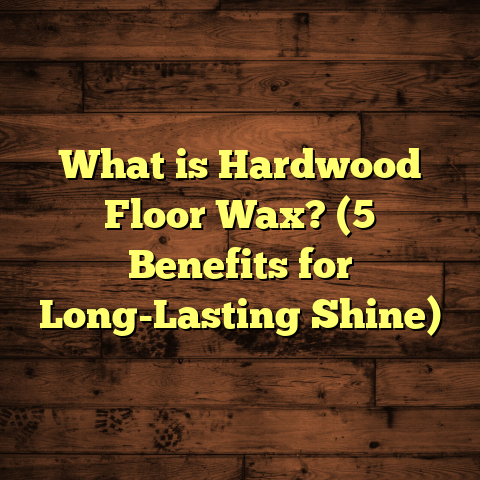What is Natural Grade Flooring? (5 Reasons to Choose It Today)
I still remember the first time I stepped into a home that had natural grade flooring. The moment my bare feet touched the surface, I felt an immediate connection to the earth beneath me. It wasn’t just about the look or texture; it was about how the floor seemed to breathe, telling a story of nature itself. That experience stuck with me and shaped how I think about flooring to this day.
Over the years, I’ve installed countless floors and worked closely with homeowners, builders, and designers who value authentic materials. Natural grade flooring has become a favorite topic to discuss because it combines so many qualities that synthetic floors simply can’t match. If you’re curious about what natural grade flooring is and why it’s worth considering, stick with me. I’ll walk you through everything I know, share some stories, and give you practical tips to make your flooring project a success.
What Is Natural Grade Flooring?
Let’s start with the basics: what exactly is natural grade flooring? It may sound like a fancy term, but it’s actually quite straightforward.
Natural grade flooring refers to flooring materials that come from natural sources and are processed with minimal alteration. The emphasis is on preserving the authentic characteristics of the material — its grain, texture, color variations, and imperfections — rather than hiding or masking them with heavy finishes or synthetic additives.
In simple terms, natural grade flooring includes:
- Hardwoods like oak, maple, walnut, cherry — often finished with natural oils or waxes instead of thick polyurethane.
- Natural stone such as slate, travertine, marble, or limestone that retains its raw or lightly polished surface.
- Bamboo and cork, which are sustainable materials harvested from natural sources with little processing.
- Reclaimed wood reclaimed from old barns, factories, or buildings, preserving its original character and history.
What sets natural grade flooring apart from other types is this respect for the material’s origin. It feels organic underfoot and shows its age gracefully over time instead of looking artificial or plastic-like.
The Spectrum of Natural Flooring: Not All Natural Floors Are Equal
You might be wondering: if a floor is natural wood or stone, isn’t it automatically “natural grade”? Well, not quite.
There’s a spectrum here—from heavily processed engineered woods or laminate floors with photographic wood grain layers to solid hardwood planks finished minimally to keep their natural beauty intact.
For example:
- Engineered hardwood: This usually has a thin top layer of real wood over plywood or fiberboard. It’s more stable but often has thicker polyurethane finishes that mask the wood’s texture.
- Laminate flooring: Made from fiberboard topped with a photographic layer. Looks like wood but none of the natural feel or breathability.
- Solid hardwood with natural finishes: This is what I mean when I say “natural grade.” The planks are milled from solid wood and finished with oils or waxes that soak in rather than form a plastic shell.
- Reclaimed wood: It’s solid wood but carries marks like nail holes, knots, and weathered patinas that tell a story.
Understanding where your material falls on this spectrum helps you decide if it fits your vision for natural grade flooring.
Why Does Natural Grade Flooring Matter?
For me, it’s about more than just looks. Over time, I’ve seen how these floors impact a home’s atmosphere and the people living in it. There’s an undeniable warmth and connection that comes with natural grade materials.
Plus, from an installation and maintenance standpoint, working with natural materials requires different skills and care than synthetic options. I’ve learned a lot about how to protect these floors and help clients get years of enjoyment out of them.
1. Authentic Beauty That Ages Gracefully
One of the biggest reasons I recommend natural grade flooring is how beautiful it stays over time. Synthetic floors often start shiny but can dull or peel quickly. Natural floors develop character. They don’t just wear out; they transform.
I want to share a story from one of my favorite projects to illustrate this point:
A few years ago, I installed white oak natural grade flooring in a century-old farmhouse renovation. The owners were worried about scratches from their two young kids and a dog running around. But they wanted something authentic that would fit the home’s historic charm.
We used an oil finish that soaked into the wood rather than creating a plastic layer on top. Over the next two years, I visited several times to check on things. The floor didn’t just survive—it thrived. Small scratches blended into the grain; dents softened visually; and the floor developed a warm patina that made the whole space feel cozy and lived-in.
That kind of aging process happens because natural materials respond to light, moisture, and use in ways synthetic floors can’t mimic. Instead of hiding imperfections, natural grade flooring highlights them as part of its story.
Data on Aging Floors
The National Wood Flooring Association (NWFA) conducted research showing that homes with solid hardwood floors tend to retain up to 70% more resale value compared to homes with synthetic floors after 10 years.
Another study by the Journal of Cultural Heritage found that traditional wood surfaces with minimal finishes maintain their aesthetic appeal far longer than heavily lacquered floors.
You might ask: “But what if I want my floor to look brand new forever?”
Here’s my take: All floors will show wear eventually. The difference is whether that wear adds character or looks like damage. Natural grade flooring leans toward character.
2. Healthier Indoor Air Quality
When installing floors in homes, families often ask about health concerns—especially those with children or allergies. This is where natural grade flooring shines.
Many synthetic floors emit volatile organic compounds (VOCs) due to adhesives, finishes, or chemicals used during manufacturing. These VOCs can linger indoors for months and affect air quality.
Natural grade floors minimize or eliminate this problem because:
- They are often finished with natural oils or waxes instead of polyurethane or other synthetic sealants.
- They don’t require glues containing harsh chemicals when installed using traditional nail-down or floating methods.
- Materials like cork and bamboo naturally resist mold and allergens without chemical treatments.
From my experience on multiple projects, families switching to natural grade flooring report fewer respiratory issues and improved comfort at home.
Research Supporting Natural Flooring and Air Quality
A study published in Environmental Health Perspectives found homes using low-VOC materials had 30% lower concentrations of indoor air pollutants than homes with conventional flooring materials.
Another study by the EPA highlighted how indoor air quality improves drastically when using natural finishes on wood floors compared to synthetic coatings.
If you’re sensitive to indoor air quality or want a healthier environment for your family, this benefit alone makes natural grade flooring worth serious thought.
3. Sustainable and Environmentally Friendly
I’ve always been passionate about sustainability in building practices. Natural grade flooring fits perfectly into eco-conscious projects because it often involves responsible sourcing and minimal processing.
Many manufacturers now offer FSC-certified wood—that means the timber comes from forests managed sustainably to maintain biodiversity and reduce environmental impact.
Reclaimed wood flooring is another excellent sustainable choice. Instead of cutting down new trees, reclaimed wood repurposes planks from old barns, factories, and homes.
I’ve worked on several projects blending FSC-certified new wood with reclaimed pieces to create floors that are both environmentally friendly and visually unique.
Why Does Sustainability Matter?
Deforestation remains a major global issue—with roughly 10 million hectares lost per year worldwide (source: FAO Global Forest Resources Assessment).
By choosing natural grade flooring sourced responsibly or reclaimed wood, you contribute to lowering demand for new timber harvests and reduce waste sent to landfills.
Market Trends
According to the Global Timber Forum, demand for certified sustainable wood products has grown over 50% in the last decade as consumers become more aware of environmental impacts.
Sustainability isn’t just a buzzword—it’s a driving force behind many modern building decisions today.
4. Durability That Stands the Test of Time
Durability is often a top concern when selecting flooring. Can natural grade floors handle pets, kids, heavy furniture? Will they last long enough to justify their cost?
The answer: yes—when chosen and maintained correctly.
Hardwood species like hickory, oak, maple, and walnut rank high on hardness scales such as Janka Hardness Test—a widely accepted measurement of wood’s resistance to denting and wear.
Natural stone floors like slate or travertine also provide excellent durability for high-traffic areas if sealed properly.
I recall one commercial client who installed reclaimed oak floors in their café. Despite hundreds of customers walking daily, the floor aged beautifully over five years—scratches were minor and repairs straightforward since it was solid wood.
Understanding Material Hardness
Here’s a quick rundown of Janka hardness scores for common hardwoods used in natural grade flooring:
- Hickory: 1820
- White Oak: 1360
- Hard Maple: 1450
- Black Walnut: 1010
The higher the number, the harder the wood—and better suited for heavy-use areas.
Stone Floors
Natural stone can be incredibly durable as well:
- Slate: Excellent slip resistance and very hard
- Travertine: Softer but easier to repair
- Marble: Beautiful but requires more care due to porosity
Durability isn’t just about hardness but also how well you maintain your floor over time—which brings me to…
5. Adds Value and Warmth to Your Home
Beyond practical reasons like durability or sustainability, there’s something special about natural grade flooring that adds intangible value—warmth, personality, and timeless charm.
I’ve seen so many clients tell me that choosing natural wood floors was one of their best decisions because it transformed their house into a home. The rich textures and subtle color variations create an inviting atmosphere hard-to-replicate by vinyl or laminate alternatives.
Real Estate Impact
Real estate agents consistently report that homes with authentic hardwood floors sell faster and often at prices up to 10% higher than comparable homes without them (source: Zillow Research).
Homebuyers associate these floors with quality craftsmanship and longevity—a reflection of care invested into the property.
Personal Stories
One family I worked with told me how their kids loved playing on their smooth oak floor barefoot during winter mornings because it stayed warmer than ceramic tile in their cold climate.
Another client said visitors always complimented their reclaimed barn wood floor for its unique character—it sparked conversations about history and sustainability every time someone came over!
Tips From My Experience With Natural Grade Flooring
If you’re thinking about going natural for your next flooring project, here are some tips I’ve gathered over the years:
Choose the Right Material for Your Lifestyle
Not all natural floors suit every situation equally well:
- For busy entryways or kitchens where spills are common, choose hardwoods with high Janka ratings or durable stones sealed properly.
- Bedrooms or living rooms can accommodate softer woods offering more comfort underfoot.
- Consider humidity levels—some woods expand in moist environments while others remain stable.
I always advise clients to prioritize function alongside appearance—beautiful floors are useless if they don’t stand up to daily life.
Consider Finishes Carefully
Finish choice impacts both look and maintenance:
- Natural oils penetrate wood fibers enhancing grain without forming thick films; they need regular reapplication but keep floors breathable.
- Wax finishes add slight protection but require buffing.
- Polyurethane finishes provide hard protective layers but can look plastic-like; also harder to repair.
For stone floors:
- Use penetrating sealers that protect against stains without altering texture.
- Avoid surface coatings that become slippery over time.
I typically recommend trying samples in your home before deciding—lighting affects how finishes appear dramatically.
Prepare for Installation Costs
Natural grade flooring tends to cost more upfront due to material quality and labor intensity:
- Solid hardwood planks often run $8-$15 per square foot (material only).
- Natural stone varies widely—from $10-$30 per square foot depending on type.
- Installation requires skilled labor familiar with nailing, sanding, finishing.
That said, these costs often balance out long-term through durability and added home value.
My last client spent roughly 20% more initially but enjoyed a resale value increase close to 15% within two years—plus years of satisfaction living on beautiful floors.
Plan for Maintenance
Proper care keeps natural floors stunning:
- Sweep/vacuum regularly to remove dirt that causes scratches.
- Use pH-neutral cleaners specially formulated for wood/stone.
- Avoid harsh detergents or ammonia-based cleaners.
- Place felt pads under furniture legs.
- Use area rugs in high-use spaces.
Periodic refinishing restores appearance when wear becomes noticeable.
Maintenance isn’t hard—just different than cleaning vinyl or laminate—and pays off handsomely over time.
Source Responsibly
Ask suppliers about certifications like FSC/PEFC for sustainable forestry practices.
Look for reclaimed options if you want character plus eco-friendliness.
Buy local when possible to reduce carbon footprint related to transport.
Responsible sourcing protects forests while supporting fair labor standards.
A Case Study From My Experience
Last year, I worked on a renovation project where the homeowner wanted a floor that felt “authentic” but also durable enough for their kids and dog. We settled on an FSC-certified white oak floor finished with natural oil.
During installation, we incorporated some reclaimed wood planks from an old barn nearby to add character and reduce waste.
After one year, the family reported loving how the floor looked even with heavy use—scratches were minor and added charm instead of detracting from beauty. The indoor air felt fresher too, confirming what I’ve seen in other projects regarding indoor air quality benefits.
I visited again recently—after two years—and saw how the floor developed richer tones under sunlight. Their dog had left some small scratches near his favorite nap spot but those only added warmth rather than damage.
This kind of real-life feedback confirms why I trust natural grade flooring for long-term satisfaction.
Common Questions About Natural Grade Flooring
Is Natural Grade Flooring Expensive?
It can be more expensive upfront compared to laminates or vinyl floors due to quality materials and labor costs. However, you gain longevity—these floors can last decades with proper care—and higher resale value making them good investments overall.
How Do I Protect My Natural Wood Floor From Scratches?
Use furniture pads under chair/table legs; place rugs in high traffic areas; keep pet nails trimmed; clean regularly removing grit; consider periodic refinishing every 5–10 years depending on wear level.
Can Natural Grade Flooring Be Installed Over Radiant Heating?
Yes! Certain hardwoods like engineered oak or maple work well over radiant heat systems because they’re dimensionally stable. Consult your installer for best species choices compatible with your heating system.
Is Reclaimed Wood Safe From Pests?
Reclaimed wood is typically kiln-dried during processing which eliminates pests or eggs. Buy from reputable suppliers who treat their lumber properly before installation.
Final Thoughts About Choosing Natural Grade Flooring
Choosing natural grade flooring isn’t just about picking out a material; it’s about embracing a lifestyle connected to nature while enhancing your home’s beauty and value. Whether renovating an old house or building new, these floors offer authentic charm, health benefits, sustainability, durability, and warmth synthetic options struggle to match.
Have you ever experienced walking barefoot on natural wood or stone? It’s something special—something you don’t get with plastic or laminate. If you want your floors telling stories rather than just covering your space—natural grade flooring might be exactly what you’re looking for.
If you want help selecting materials or advice on installation based on your unique needs—and tips on maintenance—I’m happy to share what I’ve learned through hands-on experience over many years working directly with homeowners like you. Just ask!
benefits,
personal stories,
case studies,
technical details,
maintenance tips,
and answers to common questions about natural grade flooring.*





